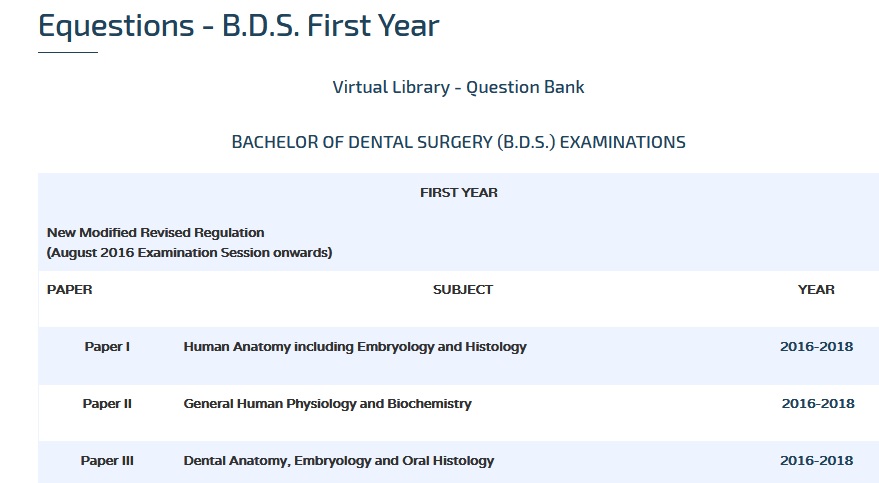General Pathology And Microbiology BDS Question Bank : web.tnmgrmu.ac.in
Name of the University : The Tamilnadu Dr. M.G.R. Medical University
Degree : BACHELOR OF DENTAL SURGERY (B.D.S)
Subject Code/Name : 4171/General Pathology And Microbiology
Year : I
Paper : II
Document Type : Question Bank
Website : web.tnmgrmu.ac.in
Download Model/Sample Question Paper :
2011-2014 : https://www.pdfquestion.in/uploads/web.tnmgrmu.ac.in/Dental/3541-1-544172KU.pdf
1990-2000 : https://www.pdfquestion.in/uploads/web.tnmgrmu.ac.in/Dental/3541-2-544135KC.pdf
2001-2014 : https://www.pdfquestion.in/uploads/web.tnmgrmu.ac.in/Dental/3541-3-544135KU.pdf
TN MGRMU Pathology & Microbiology Question Paper
February 2011 :
[KY 704] Sub. Code: 4171
SECOND B.D.S DEGREE EXAMINATION ;
Related / Similar Question Paper :
TNMGRMU BDS Oral Pathology & Microbiology Question Bank
(Regulations for the candidates admitted from 2008-09 onwards)
Paper I : GENERAL PATHOLOGY AND MICROBIOLOGY
Q.P. Code: 544171
Time: Three hours
Maximum: 70 Marks
Answer ALL questions :
Part A : PATHOLOGY
I. Essay: (1 x 15 = 15)
1. Define Thrombosis. Discuss the factors favouring Thrombus formation. Add a note on the fate of Thrombus.
II. Write short notes on: (2 x 5 = 10)
1. Fracture healing.
2. Blood and bone marrow picture in megaloblastic anaemia.
III. Short answer questions: (5 x 2 = 10)
1. Ghon complex.
2. Differences between exudates and transudate.
3. Dystrophic calcification.
4. Types of Hodgkin’s Lymphoma.
5. Ameloblastoma.
Part B : MICROBIOLOGY
I. Essay: (1 x 15 = 15)
1. Classify Anaerobes. Write detail about the various Anaerobic culture methods.
II. Write short notes on: (2 x 5 = 10)
1. ELISA.
2. Bacterial conjugation.

III. Short answer questions: (5 x 2 = 10)
1. Name two methods of dry heat sterilization.
2. Cysticercosis.
3. Name two selective media.
4. Ziehl Neelsens staining.
5. Streptococcus mutans.
August 2011
Answer ALL questions :
Answer Section A and B in Separate Answer Books :
SECTION – A :
(GENERAL PATHOLOGY)
I. Essay Questions: (1 x 20 = 20)
1. Define Neoplasm. Discuss the etiology and laboratory diagnosis of Cancer.
II. Write Short notes on : (5 x 6 = 30)
1. Pathological calcification.
2. Kidney in diabetes.
3. Peripheral blood smear and bone marrow pictures of chronic myeloid leukemia.
4. Agranulocytosis.
5. Hemophilia A.
SECTION – B :
(MICROBIOLOGY)
I. Essay Questions: (1 x 20 = 20)
1. Describe the Morphology, Pathogenesis, Laboratory Diagnosis and Immunoprophylaxis of Clostridium tetani.
II. Write Short notes on : (5 x 6 = 30)
1. Chemical Disinfectants.
2. Cultivation of Viruses.
3. ELISA.
4. Dimorphic Fungi.
5. Dental Plaque.
Answer ALL questions in the same order :
Draw Suitable diagrams wherever necessary :
Answer Section A and B in Separate Answer Books :
SECTION –A :
(GENERAL PATHOLOGY)
I. Elaborate on: (1X10=10)
1. Define inflammation. Mention chemical mediators. Write about their role in inflammation.
II. Write notes on: (5×5=25)
1. Define necrosis. Classify necrosis
2. Peripheral blood smear in and bone marrow picture in megaloblastic anemia
3. Chemical carcinogens
4. Etiopathogenesis of atherosclerosis
5. Von Willie brandts disease
SECTION – B :
(MICROBIOLOGY)
I. Elaborate on: (1×10=10)
1. Describe morphology, mode of spread, important clinical features, laboratory diagnosis and active immunization of Corneybacterium diptheriae.
II. Write notes on: (5×5=25)
1. Candidiosis
2. Dental plaque
3. Hookworm infestation
4. Bacterial capsule
5. ELISA
February 2012
Answer ALL questions in the same order :
SECTION –A :
(GENERAL PATHOLOGY)
I. Elaborate on: Pages Time Marks
1. Define Amyloidosis. Describe the pathological changes in the organs. Add a note on the special stains for Amyloid. 19 30 20
II. Write Notes on:
1. Define Necrosis. Classify with examples. 3 10 5
2. Summary of chemical mediators in inflammation. 3 10 5
3. Congenital Syphilis. 3 10 5
4. Caisson’s Disease. 3 10 5
5. Pre-Neoplastic conditions. 3 10 5
6. Laboratory findings in Iron Deficiency Anaemia. 3 10 5
SECTION –B :
(MICROBIOLOGY)
I. Elaborate on:
1. Explain the morphology, pathogenesis, symptoms and laboratory diagnosis of Hepatitis B Virus. Add a note on prophylactic measures. 19 30 20
II. Write Notes on:
1. Hot air oven. 3 10 5
2. Oral thrush. 3 10 5
3. Hydatid cyst. 3 10 5
4. Gamma globulin. 3 10 5
5. Toxins of Staphylococcus. 3 10 5
6. Plasmodium falciparum. 3 10 5
General And Dental Pharmacology And Therapetutics :
I. Essays : (2 x 15 = 30)
1. Classify the drugs used for the treatment of Bronchial asthma. Discuss in detail about the mechanism of actions, adverse drug effects and interaction of Theophylline. Add a note of inhalational steroids.
2. Write the Pharmacological basis of
(a) Cholinesterase reactivators in Organophosphorus poisoning
(b) Metclopramide in the treatment of vomiting
(c) Lignacaine and adrenaline combination in dental practice.
II. Write short notes on : (6 x 5 = 30)
1. Ketorolac
2. Second generation antihistamines
3. Sulfonyl ureas
4. Microsomal enzyme induction
5. Synthetic atropine substitutes
6. Pre anaesthetic medication.
III. Short answers questions : (5 x 2 = 10)
1. Prophylaxis of Migraine
2. Therapeutic index
3. Four examples for dentrifices
4. Four examples for local haemostatics
5. Post antibiotic effect.
August 2012
Answer ALL questions :
I. Essay Questions : (2 x 20 = 40)
1. Classify local anesthetics. Describe the mechanism of action, various routes of administration (with suitable illustrations) and uses of Lignocaine. Write how the action of Lignocaine can be prolonged. Add a note on the differences between Lignocaine and Cocaine.
2. Enumerate the drugs used in peptic ulcer. Write the mechanism of action with suitable diagram, uses, interactions and adverse effects of Proton pump inhibitors. Add a list of drugs used in dental practice which can induce peptic ulcer and the agents that protect gastric mucosa.
II. Write Short notes on : (10 x 6 = 60)
Write the actions, uses and adverse effects of the following :
1. Co trimoxazole.
2. Atenolol.
3. Levocetrizine.
4. Furosemide.
5. Succinyl choline.
6. Domperidone.
7. Zidovudine.
8. Clopidogrel.
9. Ciprofloxacin.
10. Chloroquine.